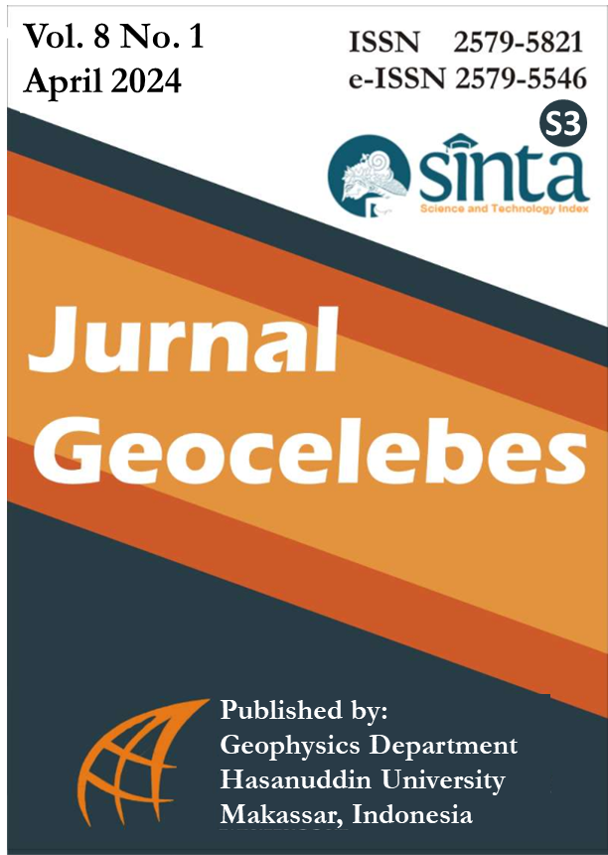Regional Lineament Pattern and Morphotectonic Analysis: The Investigation of Geological Structures and Present-Time Relative Tectonic Activity in the Tin Granite Area of Belitung Island, Indonesia
DOI:
https://doi.org/10.20956/geocelebes.v8i1.33887Keywords:
lineament, morphotectonic index, relative tectonic activity, structural geologyAbstract
Belitung Island is located on the East Coast of Sumatra and is the southernmost extension of the Southeast Asian granite belt. Despite the flat terrain of the island, numerous granite outcrops provide insight into the past tectonic activities that caused the uplift in the region. This study analyzes the current state of Belitung's tectonic activity by examining its morphotectonic index and lineament pattern. A National Digital Elevation Model (DEMNAS) dataset with a resolution of up to 8.1 m will be used to assess the geological patterns and relative tectonic activity from the surface. The relationship between the regional lineament system and morphotectonic quantification throughout the landforms of Belitung Island will also be considered. The modified Segmented Tracing Algorithm (m-STA) technique extracted the lineament features. The Index of Relative Active Tectonic (IATR) was calculated by averaging several morphotectonic indices, such as asymmetry factors (AF), stream-length index (SL), mountain-front sinuosity (Smf), and valley floor width-height ratio (VF) factors, to quantify the relative tectonic activity of the area. The combination of the two methods shows that Belitung is currently experiencing relatively weak tectonic activity compared to the past. This is supported by the surface appearance, which is mainly composed of lowlands. Several granite outcrops and highlands are aligned along the NW-SE and NE-SW directions, corresponding to the main geological structures in the area.
References
Ahmadi, H., & Pekkan, E. (2021). Fault-based geological lineaments extraction using remote sensing and GIS—A review. Geosciences (Switzerland), 11(5), 183. https://doi.org/10.3390/geosciences11050183
Andrifa, J., Sulaksana, N., Gentana, D., & Sulastri, M. (2021). Geological Lineament Pattern and Geomorphic Indices Characteristic Related To Geothermal Manifestation Appearance: A Case Study from Gunung Talang District and Its Surroundings, Solok Regency, West Sumatra Province, Indonesia. International Journal of Scientific Research in Science and Technology, 8(3), 323–336. https://doi.org/10.32628/ijsrst218358
Army, E. K., & Saepuloh, A. (2020). Field Verifications of Geological Structures Related to SAR Detected Lineaments. IOP Conference Series: Earth and Environmental Science, 417(1), 012012. https://doi.org/10.1088/1755-1315/417/1/012012
Baharuddin, & Sidarto. (1995). Peta Geologi Lembar Belitung, Sumatera (1:250,000). Puslitbang Geologi, Indonesia. https://geologi.esdm.go.id/geomap/pages/preview/peta-geologi-lembar-belitung-sumatera
Barber, A. J., & Crow, M. J. (2009). Structure of Sumatra and its implications for the tectonic assembly of Southeast Asia and the destruction of Paleotethys. Island Arc, 18(1), 3–20. https://doi.org/10.1111/j.1440-1738.2008.00631.x
Bhatt, S. C., Singh, R., Ansari, M. A., & Bhatt, S. (2020). Quantitative Morphometric and Morphotectonic Analysis of Pahuj Catchment Basin, Central India. Journal of the Geological Society of India, 96(5), 513–520. https://doi.org/10.1007/s12594-020-1590-1
Bishop, P. (2007). Long-term landscape evolution: linking tectonics and surface processes. Earth Surface Processes and Landforms, 32, 329–365. https://doi.org/10.1002/esp.1493
Cobbing, E. J., Mallick, D. I. J., Pitfield, P. E. J., & Teoh, L. H. (1986). The granites of the Southeast Asian Tin Belt. Journal of the Geological Society, 143(3), 537–550. https://doi.org/10.1144/gsjgs.143.3.0537
Eleni, K., Skilodimou Hariklia, D., Bathrellos George, D., Assimina, A., & Evangelos, K. (2015). Morphotectonic analysis, structural evolution/pattern of a contractional ridge: Giouchtas Mt., Central Crete, Greece. Journal of Earth System Science, 124(3), 587–602. https://doi.org/10.1007/s12040-015-0551-3
Eynoddin, E. H., Solgi, A., Pourkermani, M., Matkan, A., & Arian, M. (2017). Assessment of Relative Active Tectonics in the Bozgoush Basin (SW of Caspian Sea). Open Journal of Marine Science, 07(02), 211–237. https://doi.org/10.4236/ojms.2017.72016
Florinsky, I. V. (2016). Lineaments and Faults. Digital Terrain Analysis in Soil Science and Geology, 353–376. https://doi.org/10.1016/b978-0-12-804632-6.00014-6
Gentana, D., Sulaksana, N., Sukiyah, E., & Yuningsih, E. T. (2018). Index of active tectonic assessment: Quantitative-based geomorphometric and morphotectonic analysis at Way Belu Drainage Basin, Lampung Province, Indonesia. International Journal on Advanced Science, Engineering and Information Technology, 8(6), 2460–2471. https://doi.org/10.18517/ijaseit.8.6.6089
Goudie, A. S. (2004). Encyclopedia of Geomorphology. In Encylopedia of Geomorphology (eBook). Taylor & Francis.
Green, D. J. (1997). Active Tectonics Earthquakes, Uplift, and Landscape. Environmental & Engineering Geoscience, III(3), 463–464. https://doi.org/10.2113/gseegeosci.iii.3.463
Gupta, L., Agrawal, N., Dixit, J., & Dutta, S. (2022). A GIS-based assessment of active tectonics from morphometric parameters and geomorphic indices of Assam Region, India. Journal of Asian Earth Sciences: X, 8, 100115. https://doi.org/10.1016/j.jaesx.2022.100115
Hidayat, E., Muslim, D., Zakaria, Z., Permana, H., & Wibowo, D. A. (2023). Index active tectonic relative of Karangsambung geopark area, Central Java, Indonesia: assessment for developing geological disaster-based areas. IOP Conference Series: Earth and Environmental Science, 1173, 012014. https://doi.org/10.1088/1755-1315/1173/1/012014
Kumar, N., Dumka, R. K., Mohan, K., & Chopra, S. (2022). Relative active tectonics evaluation using geomorphic and drainage indices, in Dadra and Nagar Haveli, western India. Geodesy and Geodynamics, 13(3), 219–229. https://doi.org/10.1016/j.geog.2022.01.001
Laake, A. (2022). Remote Sensing for Hydrocarbon Exploration (Springer R). Springer. https://doi.org/10.1007/978-3-030-73319-3
Lehmann, B., & Harmanto. (1990). Large-scale tin depletion in the Tanjungpandan tin granite, Belitung Island, Indonesia. Economic Geology, 85(1), 99–111. https://doi.org/10.2113/gsecongeo.85.1.99
Luirei, K., Bhakuni, S. S., Longkumer, L., Kumar, V., & Jamir, I. (2021). Geomorphic assessment of the factors contributing to the evolution of landforms in Ukhaldhunga area, Kosi River valley, Kumaun Himalaya, Uttarakhand. Geosciences Journal, 25(4), 465–478. https://doi.org/10.1007/s12303-020-0034-7
Mahmood, S. A., & Gloaguen, R. (2012). Appraisal of active tectonics in Hindu Kush: Insights from DEM derived geomorphic indices and drainage analysis. Geoscience Frontiers, 3(4), 407–428. https://doi.org/10.1016/j.gsf.2011.12.002
Manjare, B. S. (2020). Morphotectonic Analysis of Upper Tapi River Sub-basin, Madhya Pradesh. Journal of Geoscience Research, 1(1), 81–88. https://www.gondwanags.org.in/wp-content/uploads/2021/11/10-JGSR-Vol-1-1-Abstracts-Manajare.pdf
Ng, S. W.-P., Whitehouse, M. J., Roselee, M. H., Teschner, C., Murtadha, S., Oliver, G. J. H., Ghani, A. A., & Chang, S. C. (2017). Late Triassic granites from Bangka, Indonesia: A continuation of the Main Range granite province of the South-East Asian Tin Belt. Journal of Asian Earth Sciences, 138, 548–561. https://doi.org/10.1016/j.jseaes.2017.03.002
Othman, A. T., & Omar, A. A. (2023). Evaluation of relative active tectonics by using geomorphic indices of the Bamo anticline, Zagros Fold-Thrust Belt, Kurdistan Region of Iraq. Heliyon, 9(7), e17970. https://doi.org/10.1016/j.heliyon.2023.e17970
Partabian, A., Nourbakhsh, A., & Ameri, S. (2016). GIS-based evaluation of geomorphic response to tectonic activity in Makran Mountain Range, SE of Iran. Geosciences Journal, 20(6), 921–934. https://doi.org/10.1007/s12303-016-0106-x
Saepuloh, A., Haeruddin, H., Heriawan, M. N., Kubo, T., Koike, K., & Malik, D. (2018). Application of lineament density extracted from dual orbit of synthetic aperture radar (SAR) images to detecting fluids paths in the Wayang Windu geothermal field (West Java, Indonesia). Geothermics, 72, 145–155. https://doi.org/10.1016/j.geothermics.2017.11.010
Shiran, M., Asadi, M. A. Z., Mozzi, P., Adab, H., & Amirahmadi, A. (2020). Detection of surface anomalies through fractal analysis and their relation to morphotectonics (High Zagros belt, Iran). Geosciences Journal, 24(5), 597–613. https://doi.org/10.1007/s12303-019-0042-7
Usman, E. (2016). the Geochemical Characteristic of Major Element of Granitoid of Natuna, Singkep, Bangka and Sibolga. Bulletin of the Marine Geology, 30(1), 45–54. https://doi.org/10.32693/bomg.30.1.2015.74
Wang, Y., Qian, X., Zhang, Y., Gan, C., Zhang, A., Zhang, F., Feng, Q., Cawood, P. A., & Zhang, P. (2021). Southern extension of the Paleotethyan zone in SE Asia: Evidence from the Permo-Triassic granitoids in Malaysia and West Indonesia. Lithos, 398–399, 106336. https://doi.org/10.1016/j.lithos.2021.106336
Zahirovic, S., Seton, M., & Müller, R. D. (2014). The Cretaceous and Cenozoic tectonic evolution of Southeast Asia. Solid Earth, 5(1), 227–273. https://doi.org/10.5194/se-5-227-2014
Zhang, Y., Yu, X., Wang, Y., Qian, X., Gan, C., Ghani, A. A., Yu, Y., & Xu, C. (2023). Reconstructing the East Palaeo-Tethyan assemblage boundary in west Indonesia: constraints from Triassic granitoids in the Bangka and Belitung islands. Geological Society, London, Special Publication, 531, 265–286. https://doi.org/10.1144/SP531-2022-144
Zhazhalayi, P. K., & Surdashy, A. (2022). Neo-tectonism and quantitative morphotectonic analysis of Roste Valley at imbricated-suture zones, Kurdistan Region, Iraq. Iraqi Geological Journal, 55(2E), 35–58. https://doi.org/10.46717/igj.55.2E.3ms-2022-11-17
Downloads
Published
How to Cite
Issue
Section
License
Authors who publish with this journal agree to the following terms:
- Authors retain copyright and grant the journal right of first publication with the work simultaneously licensed under a Creative Commons Attribution License that allows others to share the work with an acknowledgement of the work's authorship and initial publication in this journal.
- Authors are able to enter into separate, additional contractual arrangements for the non-exclusive distribution of the journal's published version of the work (e.g., post it to an institutional repository or publish it in a book), with an acknowledgement of its initial publication in this journal.
- Authors are permitted and encouraged to post their work online (e.g., in institutional repositories or on their website) prior to and during the submission process, as it can lead to productive exchanges, as well as earlier and greater citation of published work (See The Effect of Open Access).





